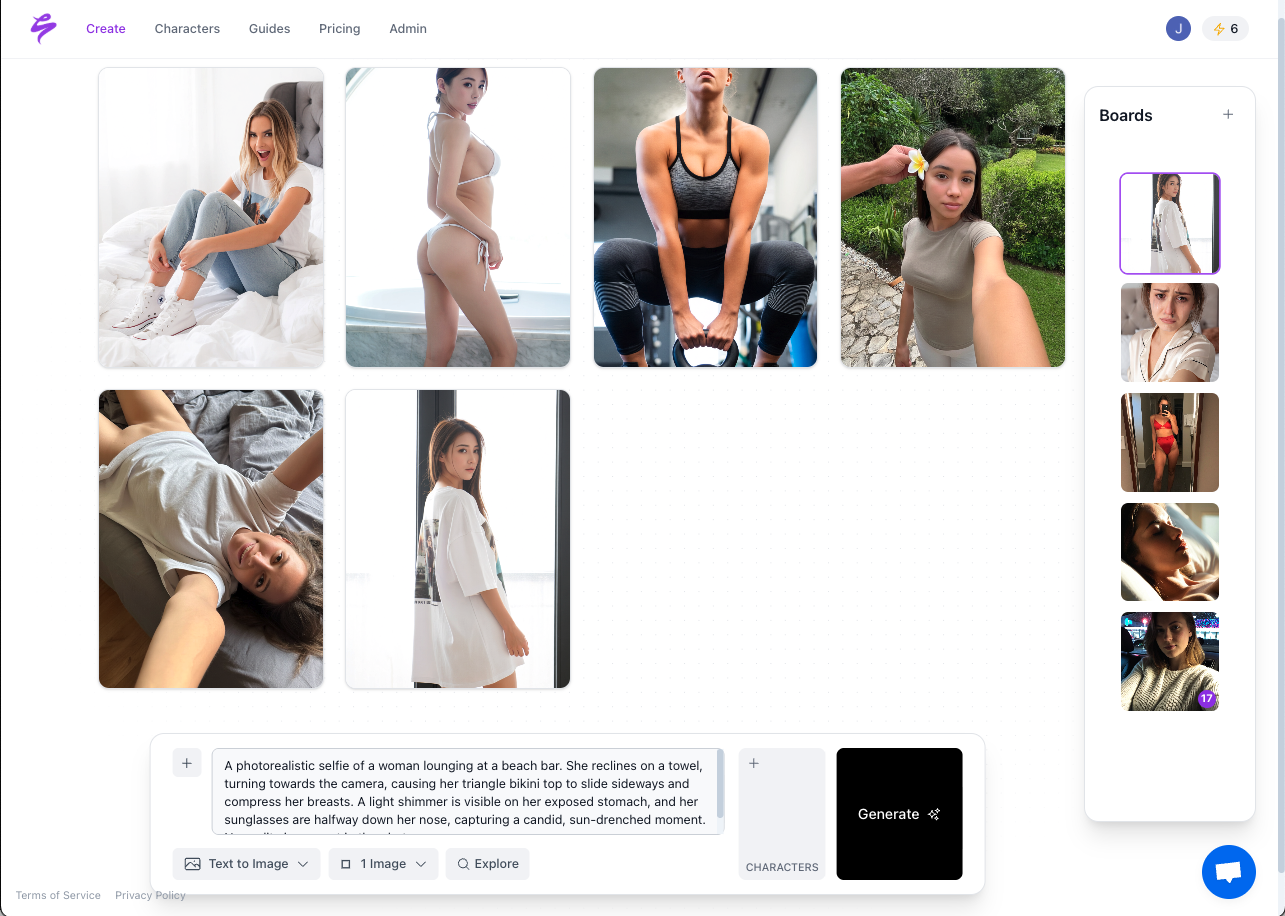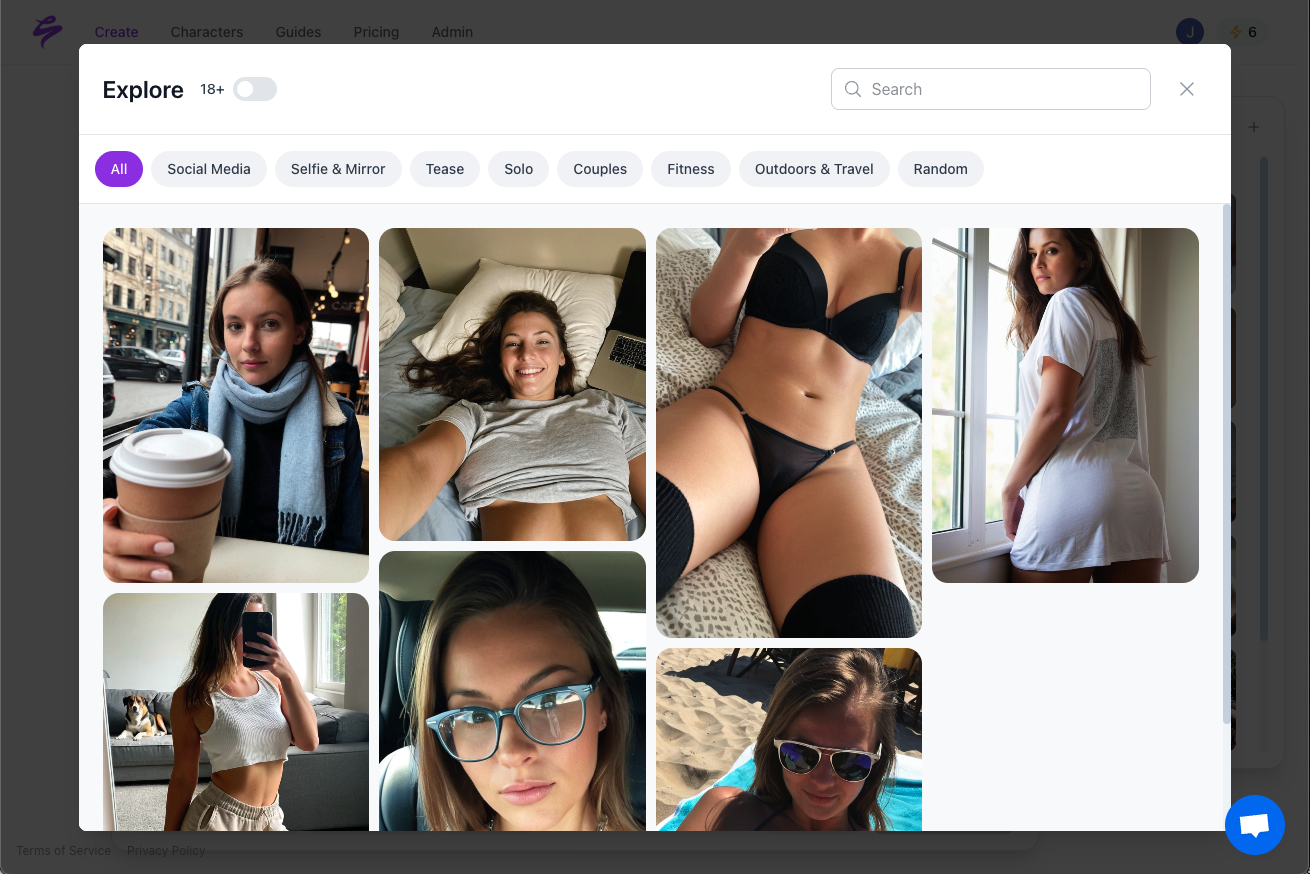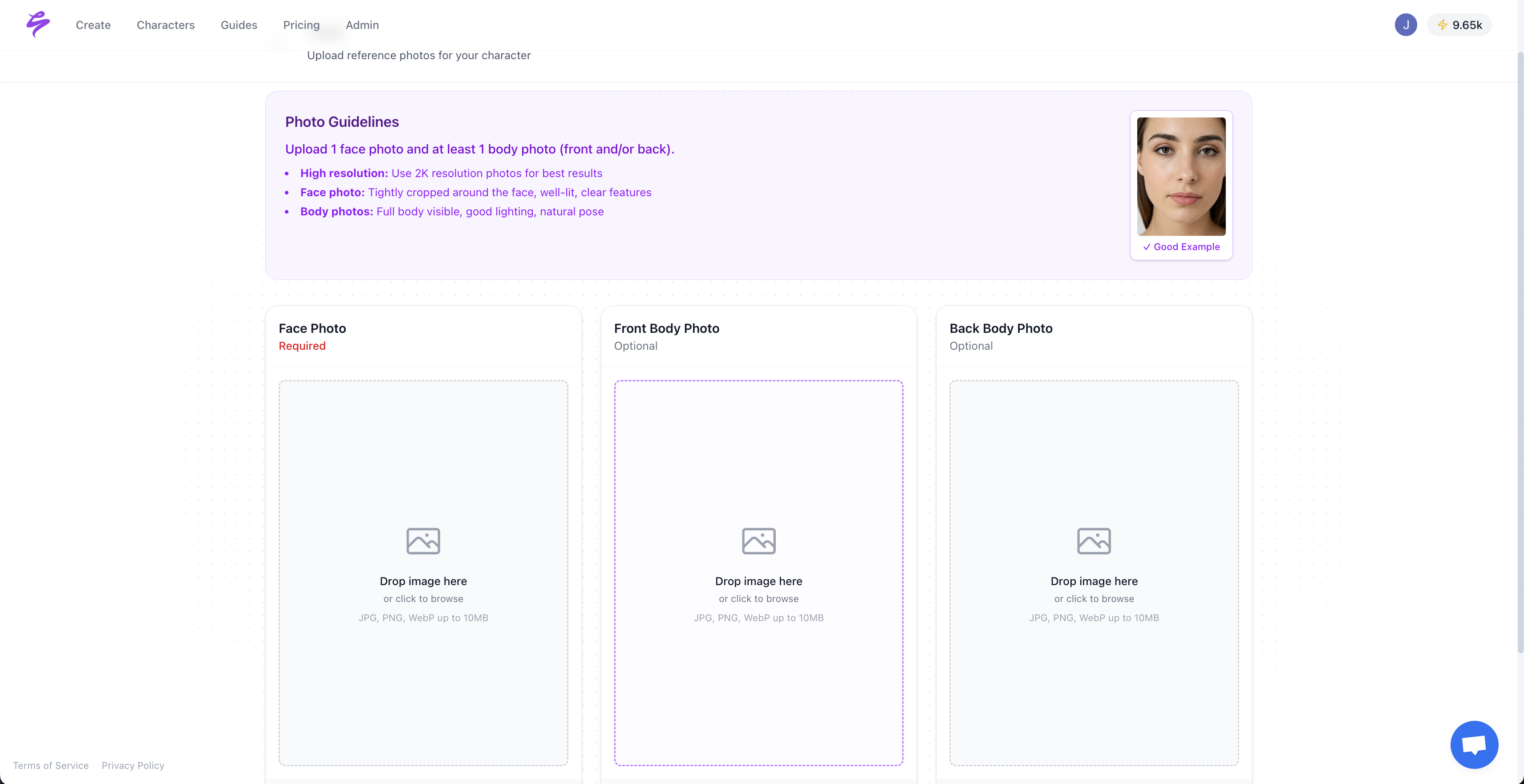Executive summary
- Virtual model content generation tools reduce the creator “Content Crisis” by turning a few reference photos into large volumes of consistent PPV content.
- Creators and agencies gain predictable posting schedules, stronger brand consistency, and more flexible monetization without adding more shooting days.
- Virtual models support diverse content types, from SFW teasers to NSFW sets, while enabling new revenue tiers and custom content offers.
- Privacy, compliance, and security improve because creators can separate their personal identity from their digital persona and control how their likeness is used.
- Purpose-built platforms like Sozee fit directly into PPV workflows, streamline operations, and help teams test, package, and ship profitable content faster.
The Creator Economy’s Content Crisis: Why Virtual Models Offer the Solution
The modern creator economy runs on a simple equation: more content leads to more traffic, sales, and revenue. Creators are human, with limited time and energy, so they cannot meet the near-constant demand for new content. This creates what many call the “Content Crisis,” a fundamental mismatch between fan expectations and creator capacity.
The industry numbers highlight this gap. Content creators face major challenges in PPV production such as maintaining a consistent content schedule, keeping up with diverse audience preferences, and overcoming initial revenue barriers due to platform thresholds. Traditional methods keep creators on a treadmill of nonstop production, which increases burnout risk, leads to uneven quality, and leaves significant revenue unrealized.
Virtual model content generation tools like Sozee address these constraints by removing many of the physical limits that apply to human-only production. Instead of relying on live shoots with specific locations, lighting, wardrobe, and energy levels, creators can generate large volumes of high-quality content that stays visually consistent. This frees time and attention for audience engagement, brand building, and strategic work.

This shift changes output volume in a measurable way. Where traditional shoots might yield 10 to 20 usable pieces of content in a month, virtual model tools can generate hundreds in the same period, each aligned with specific audience segments and PPV offers. The benefit goes beyond volume. Creators gain business models that depend less on personal stamina and more on repeatable, scalable systems.
1. Achieve Infinite Content Velocity and Beat Burnout
Virtual model tools give creators a content engine that runs independently of physical availability. Traditional production requires creators to stay constantly “on,” plan shoots, maintain personal appearance standards, manage equipment, and work through fatigue or illness to keep up with posting schedules.
Virtual tools change this pattern by allowing creators to separate creative direction from physical production. Virtual or pre-generated model content is an emerging practice to keep content fresh, scalable, and less reliant on live creators. With a platform like Sozee, creators can upload as few as three photos, train a hyper-realistic likeness, and then generate months of content during a short working session.

This higher content velocity delivers clear operational benefits. Creators can build a buffer of scheduled content during their best creative periods and protect their posting cadence during travel, illness, or time off. Reduced pressure from daily production helps prevent burnout, and the ability to generate varied content sets, from SFW teasers to NSFW collections, stabilizes revenue even when the creator steps away from day-to-day shoots.
Time savings also show up in logistics. Traditional shoots often require hours for setup, lighting, wardrobe changes, and post-production editing. Virtual model generation can produce polished, ready-to-publish content in minutes. That time can shift toward higher-value work such as audience interactions, paid community management, brand partnerships, and long-term planning.
For agencies managing multiple creators, this speed advantage compounds. Teams can fulfill content requests quickly, keep consistent posting schedules across many accounts, and scale operations without matching that growth with more crew, studio space, or travel.
Start creating high-volume PPV content with Sozee to reduce production stress while keeping your content pipeline full.
2. Unlock Predictable and Consistent Brand Representation
Brand consistency sits at the center of reliable PPV revenue. Human-only shoots often introduce visual differences in lighting, makeup, angles, location, and daily appearance that can weaken brand recognition and audience trust. Virtual model tools reduce these variables and produce steady, repeatable visual output.
PPV success depends on strong production quality and marketing strategies that rely on consistent brand presentation. Virtual models support that presentation by maintaining appearance standards regardless of production time, environmental conditions, or content volume.
Modern virtual model systems give creators detailed control over their visual identity. Creators can define signature looks, including lighting setups, framing, skin tones, hair and makeup, and branded styling elements. These can be saved as reusable templates. Reusing these templates keeps content aligned with the core brand while still allowing fresh variations.
For PPV platforms where visuals tie directly to income, this consistency leads to business gains. Fans learn to recognize the creator’s style quickly, which strengthens engagement and willingness to purchase premium sets. A consistent, polished look also positions creators as premium brands that can justify higher price points.
Virtual tools also support reusable style bundles that capture aesthetics with proven performance. Once creators identify looks that drive strong engagement or sales, they can replicate those conditions as often as needed. These become repeatable assets rather than one-off successes from a single shoot.
Brand consistency extends across entire content plans, not just single posts. Creators can produce themed series, seasonal campaigns, or character variations while keeping core elements, such as color palettes and posing styles, in place. This balance of variety and consistency helps content stay recognizable without feeling repetitive.
3. Diversify Content Offerings and Monetization Streams
Virtual model tools open up a broader content mix and new revenue options. Traditional production can make experimentation expensive because costumes, locations, props, and time require upfront investment. Virtual generation reduces these costs so creators can test more ideas with less risk.
Greater PPV reach and effectiveness hinge on real-time analytics, affiliate engines, and quick content iteration that supports diversified monetization. Virtual model platforms align with this approach by allowing creators to generate and test multiple content concepts rapidly, then double down on formats that data shows to be the most effective.
Diversification can take many forms. Creators can generate:
- Holiday and seasonal content aligned with key dates and events.
- Trend-based sets inspired by memes, current topics, or viral formats.
- Fantasy, cosplay, and themed scenarios that would be costly to stage physically.
- Custom fan-requested sets that are difficult or impractical to shoot in person.
This range makes tiered monetization strategies easier to manage. From a single likeness model, creators can develop:
- Free or low-resolution teasers for social media discovery.
- Standard subscriber content for ongoing support.
- Premium PPV drops for fans seeking exclusivity.
- High-priced custom or limited-edition sets for top supporters.
Each tier targets different audience segments and price points, so creators capture more value from each follower group.
Virtual generation also supports fast response to cultural moments. When a topic starts trending, creators can quickly publish relevant content and capture that attention window. In PPV environments where visibility algorithms reward activity, this agility can significantly affect revenue.
Virtual environments further extend what is possible. Scenes set in exotic locations, elaborate fantasy worlds, or highly stylized settings become feasible without travel or special sets. That flexibility helps creators craft distinctive brand identities and serve niche communities willing to pay more for specialized content.
Explore more PPV content formats with Sozee to build new offers without increasing your production overhead.
4. Enhance Privacy, Compliance, and Security
Privacy, regulatory pressure, and platform rules now play a central role in PPV strategy. Government policies and payment provider standards continue to evolve, which can create uncertainty for creators who rely entirely on traditional content workflows.
PPV platforms now operate under stricter compliance expectations from regulators and payment partners, so privacy and security features have become essential for long-term monetization. Virtual models give creators new ways to protect their personal identity while still building a visible, monetizable persona.
Privacy advantages go beyond simple face hiding. Creators retain full control over their likeness model and how it is used. Training occurs on private instances, so a creator’s images and likeness do not feed broader systems or shared model pools. This isolation reduces the risk of unauthorized reuse and supports creators who prefer to separate their online persona from their offline life.
Compliance management also becomes more straightforward. Virtual generation lets creators define clear content boundaries aligned with platform rules. They can configure outputs to remain inside acceptable ranges for each platform or region, which reduces the risk of suspensions, chargebacks, or payment processor disputes.
Security-focused features in professional virtual model platforms often include approval flows for agencies. Teams can collaborate on content while still limiting who can access the creator’s base images, likeness model, and final outputs. Audit trails give agencies and creators clear records for internal policies and external compliance checks.
Eliminating physical shoots further reduces exposure risks. Personal living spaces stay private, equipment is not transported or stored in multiple locations, and fewer people handle raw photos and video files. Content creation instead occurs in controlled digital environments that can be secured with modern data protection practices.
Creators who work in regions with strict content rules, or who serve global audiences with varying legal standards, can also benefit from flexible variants. A single concept can be generated in multiple compliance-friendly versions without reshooting, making it easier to adapt PPV offers across markets.
5. Optimize Workflows and Maximize Revenue per Content Item
Virtual model tools streamline how creators and agencies move from idea to published content. Traditional methods carry significant overhead, including planning, booking, shooting, editing, and packaging, which lowers the profit per piece of content.
Modern PPV workflows increasingly rely on specialized platforms to manage ticketing, encoding, delivery, and support, which shortens time to market. Virtual model generation fits into these workflows by reducing the time and effort required to create the visuals that fuel each campaign.
Workflow optimization starts with speed. Content sets that might have taken days or weeks to plan and produce with traditional shoots can often be generated in minutes. This speed allows creators to respond quickly to fan requests, promotions, or platform trends and keep their PPV offerings current.
Packaging also becomes more efficient. Platforms like Sozee are built for creator monetization workflows and can generate outputs sized and formatted for different channels. A single generation session can yield:
- Short-form teasers for social feeds.
- Standard-resolution sets for subscriber galleries.
- High-resolution collections for PPV or premium bundles.
- Customized variations tailored to individual fan requests.
Testing and optimization become easier as well. Creators and agencies can generate multiple versions of thumbnails, poses, outfits, or themes for the same offer, then measure which versions drive the best engagement or conversion. This data-led approach improves revenue per content item over time.
Integration extends through fulfillment. Custom content that previously required extensive coordination can be turned around quickly, which supports higher pricing for rush or bespoke orders while still maintaining a manageable workload.
Revenue-focused features such as curated prompt libraries help creators capture winning ideas. Once a concept proves successful, it can be stored as a reusable prompt and adapted into new sets.

Virtual Model Content Generation Tools: Sozee vs. The Rest
The virtual model content landscape includes several categories of tools, each with different strengths for PPV monetization. Sozee focuses on creator and agency workflows, while traditional methods and general-purpose AI art tools serve broader or different use cases.
|
Feature |
Sozee |
Traditional Methods (Human Creators) |
General-Purpose AI Art Tools |
|
Content Velocity |
High, on-demand, in minutes |
Limited by human availability |
Inconsistent, often generic |
|
Likeness Consistency |
Hyper-realistic, stable likeness |
Varies per shoot, human limitations |
Often uncanny, inconsistent |
|
Privacy and Anonymity |
Private likeness models, creator control |
Higher risk of personal exposure |
Few creator-specific privacy settings |
|
Monetization Workflows |
Built for creator economy PPV and NSFW use cases |
Manual effort, logistical overhead |
Not focused on monetization |
Virtual model content generation tools like Sozee provide a focused feature set for PPV creators. Hyper-realistic likeness models, content velocity, and privacy controls combine with monetization workflows, giving creators and agencies a platform that aligns with how they already sell and promote content.
These tools also support new business models. By treating content generation as a scalable system instead of a series of one-off shoots, creators can plan long-term calendars, run structured experiments, and manage content libraries more like digital products than disposable posts.

Get started with Sozee to test how a dedicated virtual model platform can support your existing PPV workflow.
Frequently Asked Questions
Q1: How do virtual model content generation tools ensure content quality for PPV?
A: Virtual model tools such as Sozee focus on realism by recreating camera behavior, lighting, and skin texture in a natural way. The goal is to avoid the artificial look that often reveals AI-generated content and instead produce images that resemble professional photography. Creators can refine outputs, lock in consistent appearance settings, and export in formats that match PPV platform requirements. The result is content that meets the production quality standards fans expect from paid experiences.
Q2: Can virtual models truly replace human creators for PPV content?
A: Virtual models extend creator capacity rather than remove the creator from the process. Creators still define the brand, direct the creative vision, and engage with fans. Virtual tools handle repetitive production tasks that consume time and energy, such as generating new sets in a familiar style. This combination lets creators protect their personal bandwidth while maintaining a steady content flow and focusing on work that directly builds community and revenue.
Q3: What are the main privacy implications of using virtual model content generation tools?
A: Mature virtual model platforms prioritize privacy and data protection for creator likenesses. Individual models remain private and are not shared across users or used for unrelated training. Encrypted storage, access controls, and clear permissions help keep creator data secure. For creators who want anonymity, virtual models make it possible to run a visible PPV brand without revealing personal identity or shooting in personal spaces. Agency workflows can include approval steps and logs that balance accountability with privacy.
Q4: How do these tools help scale PPV content production for agencies?
A: Agencies benefit from predictable, creator-independent production capacity. Virtual model tools reduce reliance on coordinated shoot schedules, travel, and studio bookings. Teams can respond to campaign needs quickly, generate content variations for testing, and keep multiple creator brands active at once. Features such as prompt libraries, style bundles, and A/B testing options help agencies document what works and apply those learnings across clients.
Q5: What technical requirements exist for implementing virtual model content generation tools?
A: Platforms like Sozee are designed for straightforward onboarding. Creators usually need to provide three to ten clear reference photos to build their likeness model. Access takes place through a web browser, so there is no need for specialized hardware or software. Content generation occurs in the cloud, and outputs are available in formats that align with major social and PPV platforms. Support resources and agency onboarding programs can help teams integrate the tools into existing workflows.
Conclusion: The Future of PPV Content is Infinite with Virtual Model Content Generation Tools
The creator economy’s Content Crisis, where demand for new material far exceeds what individuals can produce alone, highlights the limits of traditional PPV workflows. Physical shoots, complex logistics, and creator burnout all restrict how far a PPV business can scale.
Virtual model content generation tools like Sozee offer a different approach. These platforms support higher content velocity, help maintain brand consistency, expand monetization options, and strengthen privacy and compliance. Creators and agencies can keep content pipelines active without matching that output with more hours in the studio.
Early adopters can turn content production into a more predictable system. Creators gain time for community-building and strategic planning, while agencies improve utilization, campaign reliability, and return on content investment. Virtual influencer builders and digital brands get the production capacity needed to maintain consistent personas over time.
As virtual tools continue to improve, PPV content creation will likely rely increasingly on a blend of live and generated material. Workflows that combine human creativity with virtual production scale will be better positioned to handle growing audience expectations and platform demands.

Start creating with Sozee today to build a PPV content engine that supports consistent growth and long-term sustainability.
